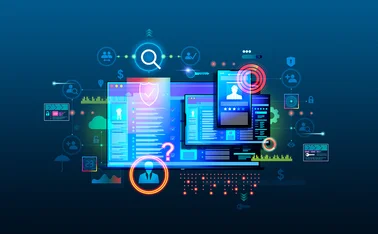Keeping good company: streamlining client onboarding with CDI – Part 3
A collaborative article by Chartis and Encompass.

This is the final part of a series of three papers that explore how to develop a corporate digital identity (CDI) strategy. The first paper assesses the extent of the ‘pain’ and inefficiency experienced in current corporate client onboarding, while the second looks at the potential uplift that can be achieved via an automated CDI system.1 This paper aims to help readers and practitioners navigate the challenges of undertaking a CDI transformation, address organizational inertia, and put together a robust and compelling case for change. In effect, it serves as both a ‘how to’ guide and a robust answer to the (highly valid) question, ‘so what?’.
Part 3: Future-proofing a corporate digital identity strategy to deliver sustainable value
As highlighted in the first paper in this series, the banking industry spends billions on managing client due diligence as part of the corporate onboarding process. A typical Tier 1 bank2 may spend upwards of US$13.2 million a year, mostly on supporting highly manual processes. The second paper in this series went further in mapping out some of the areas where an over-reliance on manual workload is causing severe pain. Crucially, it also highlighted the vast savings in effort that can be achieved by automating these workflows.
Making change a reality
What do major banks need to successfully transition their operations? Typically, the following actions are fundamental to successful transformation and change management:
- Measuring existing processes, identifying inefficiencies and pain points.
- Calculating the potential return on investment (ROI), or uplift, that can be achieved by moving from an ‘as is’ model to a ‘to be’, CDI-centric approach.
- Developing a roadmap that considers both the gain and the pain over a medium-term timescale.
- Architecting and implementing a roadmap to integrate and optimize the output of a CDI approach.
- Developing an engagement plan to ensure that stakeholders are on board with change and are supporters and advocates rather than blockers.
This paper directly supports the first three steps listed above with a set of practical tools. Chartis does not propose a model for restructuring either operations or technology architecture, as is typical in step four. And while this report only touches on step five, the tools it provides can ensure that stakeholders will be able to see the short- and long-term value of CDI. CDI typically requires significantly less rearchitecting than a conventional technology implementation (such as introducing a CLM system), so benefits can be relatively instant. However, a bank can expect these to improve incrementally over a longer period, such as the five-year period over which we have modeled impact.
Assessing and communicating the benefits
As with many new solution implementations, it is natural to experience inertia and pushback from some internal stakeholders. It is crucial that banks undergoing a CDI transformation understand the ROI it can sustainably deliver. In this context, this paper aims to provide a practical guide to understanding and estimating the ROI from CDI. With this in mind, to implement an effective CDI program, it is important to take the following steps (considered in more detail in the following sections):
- Understand the pain points in your corporate onboarding process and focus on separating out those elements that can be easily changed versus those that are longer-term targets.
- Measure the current impact of inefficiency and model the impact of change.
- Build a business case and take stakeholders on a journey.
Understanding the pain points and opportunities
The pain points in corporate client onboarding were considered in parts one and two of this series. Alongside an assessment of these, the following are key elements to consider when estimating ROI from CDI:
- Efficiency. As discussed in the first two papers, this is often an area where there is the biggest gap between existing processes – and therefore related time/resource commitments – and what can be achieved. Most banks have a strong grasp of the cost of onboarding corporate clients. At a typical Tier 1 bank, CDI can impact data and processes that can cost up to US$11 million a year. While it is unlikely that all those costs can be replaced quickly, a large proportion – up to US$4 million can be cut.
- Downstream efficiency. This area is less clear-cut. Because of the way that investigations are often handled, it may be worth conducting a time-motion study to determine how much effort banks take up in terms of investigating, decisioning and reporting – paying particular attention to the duplication of tasks and data gathering.
- Reporting and auditing. These are two of the most time-consuming and inefficient downstream processes. Both are typically carried out manually and suffer from a lack of consistency. Getting consistency in data – and therefore decisions – at the beginning of the process can save days in effort at the reporting stage. It can also help firms avoid the pitfalls of auditing decisions that have not been made using the same parameters and data.
The following adjacent opportunities lie outside the core operational focus:
- Upskilling, training and retention of staff. This is a rapidly emerging area in financial crime prevention. Institutions are realizing that providing analysts with automated rich data that informs their understanding of risk can be instrumental in thwarting fraudsters. Giving analysts proper tools helps them gain a better understanding of sources of risk, and allows them to become risk managers rather than data collection analysts focused on manual repetitive tasks. In effect, upskilling allows staff to train on the job by giving them greater visibility of risk signals, but streamlining the process can also free up time for formal training. Providing better tools can also help with staff retention: it is widely acknowledged in the industry that staff with the right tools are happier, and are therefore more likely to stay longer at a company.
- Enabling growth. A strong onboarding process can have a significant impact on commercial success, in two particular areas. Smoother and faster onboarding can have a direct impact on the customer experience, reducing churn and maximizing client lifetime value. Understanding the relative risk that corporates, and ultimately vertical sectors, pose can create huge opportunities for institutions to expand into some of those sectors. This allows some institutions to achieve a competitive advantage over peers that may seem to have a lower risk threshold, but in reality aren’t as well placed to understand and mitigate risks. The data that CDI provides can also be used for marketing and business development purposes to facilitate segmentation and targeting strategies.
- Client experience. In most if not all banks, client experience in corporate onboarding is a critical priority. This is fast becoming a non-negotiable element from the client’s point of view and is a prerequisite of a successful and long-lasting relationship. While some elements of client experience are intangible, our ROI model incorporates a number of factors that are driven directly by client onboarding experience:
- Better customer growth and attrition rates realized as booked revenue and customer lifetime value.
- Cross- and up-selling as a result of onboarding the right kind of client.
- A more frictionless ongoing experience via perpetual KYC.
Measuring the potential impact: the ROI discussion
Calculating the benefits of a CDI system is a critical step in the shift to implementing one. Chartis expects the level of pain to grow exponentially as the level of complexity – and associated risk – within clients increases, in an environment where recruiting and training analysts is significantly harder. For that reason, any ROI calculation must incorporate efficiency gains alongside adjacent commercial ones.
Calculating efficiency gains
As Figure 1 illustrates, most time is spent gathering and managing data, and on review and risk assessment. These categories are made up of several critical steps that include identity verification (IDV) and screening (see Figure 2).3
There are significant gains to be made from using automation and CDI in the commercial and adjacent aspects of onboarding. As shown in Figures 3 and 4, estimating these adjacent gains in addition to efficiency can help firms deliver a very strong ROI case, which can be critical in achieving buy-in from key stakeholders.
The ROI case is based on potential savings and additional uplift, as a percentage of total spend on corporate onboarding (including technology and people cost). Typically, about 80% of the cost is on manual effort (people and processes). CDI can cut up to two-thirds of the manual cost (59% of total cost), but this is not realized in year one. However, cutting 21% of total cost is achievable in year one through efficiency gains alone.
That is not to say that the impact of CDI can’t be significant in the first year. Up to 57% of total cost can be offset when incorporating the commercial uplift with the efficiency gains. Commercial uplift can be achieved in several ways (see Figure 4 for details). These include faster onboarding and time to value, improved drop-out and attrition rates and technology consolidation.
The model shown in Figures 3 and 4 is based on market data collected by Encompass and Chartis and reflects a use case at a typical Tier 1 bank. The intention of the model is to help stakeholders understand the value of CDI and the building blocks necessary to achieve it. Most banks will have the relevant data available.
ROI calculator
As part of this series of papers, Encompass has produced an ROI calculator that enables practitioners to build and test an ROI estimate for moving to CDI. This can be found here: www.encompasscorporation.com/roi-calculator.
Understand the longer-term impact of CDI
CDI presents banks with an opportunity to create longer-term value, so any considerations about ROI should incorporate this.
While a conservative estimate is that 21% of total costs can be offset in year one, banks should and can incrementally increase the impact of CDI as the application matures.
Looking just at the impact on efficiency, up to 59% of total costs can be offset within five years, as banks manage to upskill and repurpose analysts’ effort (see Figure 5).
As Figure 5 shows, the benefit of CDI is that it delivers incremental value and growth beyond year one, which is why it’s important to think beyond the short term. Indeed, this reflects the way that the market is moving. Chartis carried out research with tech investors at banks, and found that the average tech investment cycle is shifting from measuring impact across a two to three-year period to a five to seven-year period. The potential impact of investing in CDI reflects this perfectly: while the impact can be instant, the incremental benefits by year five can be more than double.
Two areas that can easily be missed, however, but which lay the foundation for long-term success, are the application of perpetual KYC and improved customer experience.
- Moving to a perpetual KYC model can have significant impact on reducing manual processes, managing spikes in activity and improving detection on an ongoing basis.
- CDI provides the digital records that can be monitored and maintained as part of a perpetual or continuous KYC program. When there is change in public or private data it can be flagged for refresh and enable the trigger of a materiality assessment request.
- Faster onboarding, and a reduction in firms’ ‘back and forth’ with clients, can have a significant impact on customer experience. And this has a proven link to a number of metrics, including customer attrition, up- and cross-sales and customer lifetime value.
Building a business case – take stakeholders on a journey
Despite the compelling ROI story, it is important that banks help their internal stakeholders, many of whom will initially be detractors, to understand the value that CDI can have.
Figure 6 shows the typical CDI-related pushbacks that firms can expect, and how to respond to them to turn detractors (the yellow icon) into advocates (the blue icon). As the figure shows, taking stakeholders on a gradual journey will convert them from detractors to advocates. An ROI equation like the one illustrated above can help in this by demonstrating strong ROI, while being transparent about how this calculation has been achieved and spelling out key assumptions and risks.
Conclusion
Ultimately, CDI is one of the key stepping stones toward understanding not only a bank’s portfolio but also its ecosystem (i.e., the wider supply and value chain beyond its existing clients).
In 2024, Chartis conducted research with a broad range of banks and financial institutions, and identified that many see the end state as achieving a dynamic view of portfolio and ecosystem risk. One of the key components in attaining this is having a consistent and automated view of corporate risk. Very few banks, however, feel that they are anywhere near this end state. But many are actively looking for solutions to take them at least a step closer.
Ultimately, a move to automating corporate client onboarding is essential, whether it is done now or in the future. We do not underestimate the barriers to adoption of new technologies, including CDI, which is why this three-part paper aims to offer assistance to those looking to explore and invest in it.
- In paper one, we dissected the time, effort and resources that corporate onboarding and due diligence currently take up, and highlighted some of the key pain points. Based on robust research from Chartis and Encompass, from a broad set of case studies and data points, it is clear that there are significant gaps that can be closed. Our conclusion is that onboarding should be a key target for many risk and compliance officers.
- Paper two explored the key areas of the corporate onboarding and review cycle where CDI can have the greatest impact, to help readers develop an action plan.
- In this paper, we have assembled a set of models based on deep research and data, to help support firms’ ROI and planning efforts and guide readers on a journey of transformation.
But each business is unique, and it is vital that banks understand their own case studies and use cases. Institutions can use these three papers as a guide, and a conversation starter, to set them off on their own particular journey.
Notes
1. CDI platforms provide a holistic view of client risk, including private and public data in real time, and generate client profiles on demand. Put simply, CDI is a way to combine structured and unstructured data into a single and comparable risk identity that can be integrated into various stages of the onboarding and review processes.
2. A Tier 1 bank is defined as a bank with more than US$500 billion in assets.
3. In an example of a bank with 20,000 corporate clients, these two categories (gathering/managing data and review/risk assessment) can deliver more than 200,000 hours of people time. If outreach is incorporated into the equation, the time saving is considerably greater and can lead to an efficiency saving of 32% of the time spent. Even though the efficiency gains are substantial, the assumption is that only a proportion of this efficiency gain can be realized in year one (approximately 40%, using typical estimates).
Encompass enables fast, accurate identity validation and verification of corporate customers, and a gold standard approach to KYC. Our award-winning corporate digital identity (CDI) platform incorporates real-time data and documents from authoritative global public data sources and private customer information, to create and maintain digital risk profiles.
Utilizing the expertise of a global transformation team of KYC and banking industry experts, as well as strategic data, technology and consulting partnerships, enables seamless integration of Encompass into existing workflows and systems. With Encompass the world’s leading banks improve customer experience and increase business opportunities through consistent regulatory compliance and risk mitigation.
Only users who have a paid subscription or are part of a corporate subscription are able to print or copy content.
To access these options, along with all other subscription benefits, please contact info@risk.net or view our subscription options here: http://subscriptions.risk.net/subscribe
You are currently unable to print this content. Please contact info@chartis-research.com to find out more.
You are currently unable to copy this content. Please contact info@chartis-research.com to find out more.
Copyright Infopro Digital Limited. All rights reserved.
As outlined in our terms and conditions, https://www.infopro-digital.com/terms-and-conditions/subscriptions/ (point 2.4), printing is limited to a single copy.
If you would like to purchase additional rights please email info@chartis-research.com
Copyright Infopro Digital Limited. All rights reserved.
You may share this content using our article tools. As outlined in our terms and conditions, https://www.infopro-digital.com/terms-and-conditions/subscriptions/ (clause 2.4), an Authorised User may only make one copy of the materials for their own personal use. You must also comply with the restrictions in clause 2.5.
If you would like to purchase additional rights please email info@chartis-research.com






